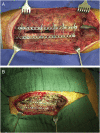Unexpected results after sternal reconstruction with plates, cables and cannulated screws
- PMID: 26819274
- PMCID: PMC4892144
- DOI: 10.1093/icvts/ivv402
Unexpected results after sternal reconstruction with plates, cables and cannulated screws
Abstract
Objectives: During the last decade, various plate fixation systems have been developed for the treatment of complicated sternal dehiscence after open-heart surgery. One of them is the Modular Sternal Cable System© (MSCS), which promises optimal distribution of forces along the whole sternum by using plates, cannulated screws and cables. However, in comparison with other systems, there is a lack of outcome data.
Methods: Sternal reconstruction with the MSCS was performed in 11 patients (male n = 10, age 72.0 ± 7.3 years) with complicated sternal dehiscence following cardiac surgery, and 73% of them had a history of sternal infection. Sternal reconstruction included bilateral longitudinal plating and thoracic re-closure with 4-9 cables. Patients received postoperative examination, focusing on sternal wound conditions and clinical stability. If there was any suspicion of recurrent wound infection, computed tomographic scans were done in the early postoperative period or in the long term, in order to evaluate bony consolidation and integrity of osteosynthetic material.
Results: The mean operation time was 165 ± 59 min, the mean intubation time 4.7 ± 5.3 min and the mean intensive care unit length of stay was 1 day (median) (range 1-23 days), with a total hospital stay of 9 days (median) (range 5-64 days). Operative mortality was 0%. One patient died on the 65th postoperative day of a non-MSCS-related cause. Sternal wound infection occurred in 6 patients (54.5%) and made hardware removal necessary in 5 of them early postoperatively (median 14 days) and in 1 patient late postoperatively (1058 days). In another patient, material was removed 715 days after MSCS application due to persisting sternal pain.
Conclusions: A high incidence of postoperative wound infections was observed after implantation of the MSCS. It may be speculated that hardware design (e.g. the absence of a locking system, large screws) compromises osseous microcirculation, favouring the development of infection. This should be kept in mind for further development of sternal reconstruction systems.
Keywords: Osteosynthesis; Rigid plate fixation; Sternal dehiscence.
© The Author 2016. Published by Oxford University Press on behalf of the European Association for Cardio-Thoracic Surgery. All rights reserved.
Figures



Comment in
-
eComment. Complex and novel versus simple and traditional approaches for sternal closure.Interact Cardiovasc Thorac Surg. 2016 May;22(5):667. doi: 10.1093/icvts/ivw070. Interact Cardiovasc Thorac Surg. 2016. PMID: 27114395 Free PMC article. No abstract available.
References
-
- Julian OC, Lopez-Belio M, Dye WS, Javid H, Grove WJ. The median sternal incision in intracardiac surgery with extracorporeal circulation; a general evaluation of its use in heart surgery. Surgery 1957;42:753–61. - PubMed
-
- Losanoff JE, Jones JW, Richman BW. Primary closure of median sternotomy: techniques and principles. Cardiovasc Surg 2002;10:102–10. - PubMed
-
- Losanoff JE, Richman BW, Jones JW. Disruption and infection of median sternotomy: a comprehensive review. Eur J Cardiothorac Surg 2002;21:831–9. - PubMed
-
- Ottino G, De Paulis R, Pansini S, Rocca G, Tallone MV, Comoglio C et al. . Major sternal wound infection after open-heart surgery: a multivariate analysis of risk factors in 2,579 consecutive operative procedures. Ann Thorac Surg 1987;44:173–9. - PubMed
-
- Demmy TL, Park SB, Liebler GA, Burkholder JA, Maher TD, Benckart DH et al. . Recent experience with major sternal wound complications. Ann Thorac Surg 1990;49:458–62. - PubMed
MeSH terms
LinkOut - more resources
Full Text Sources
Other Literature Sources
Medical
Miscellaneous

